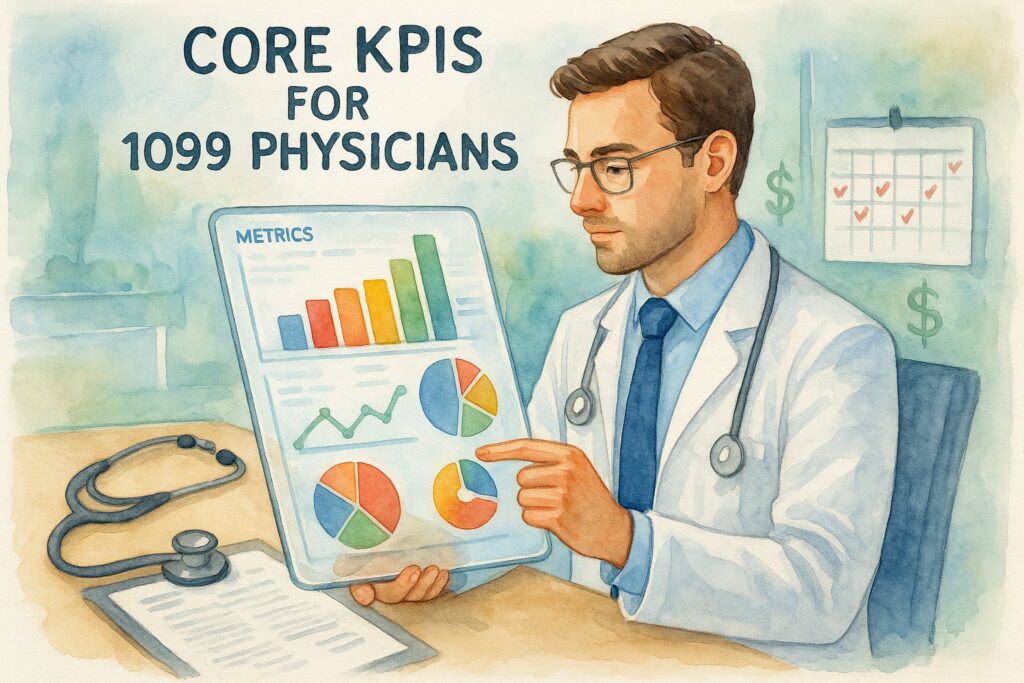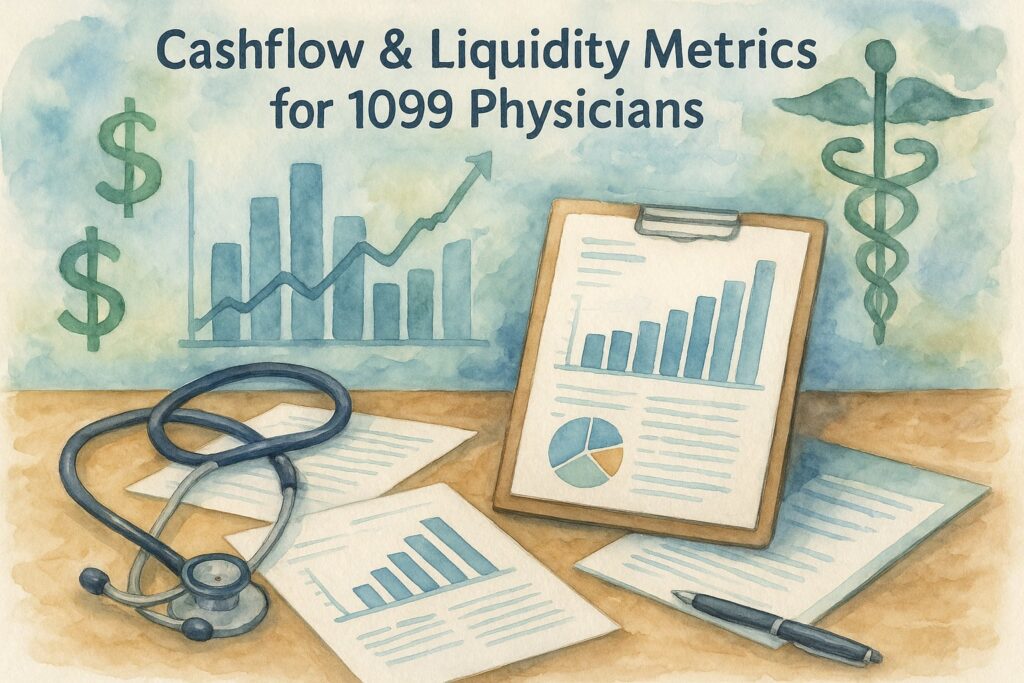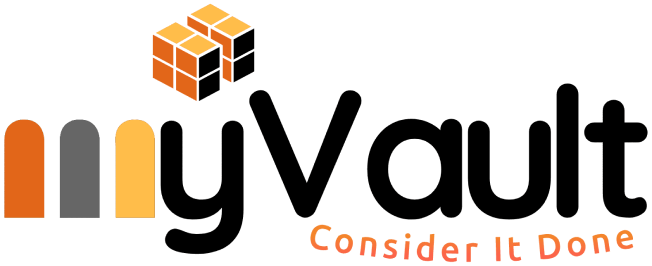
Running your own practice as a 1099 physician or physician assistant means you carry full responsibility for both patient care and financial performance. Unlike employed positions, your income, expenses, and long-term stability depend on how well you track and manage your numbers. The most effective way to stay financially healthy is by monitoring key performance indicators (KPIs) that show exactly where your practice stands.
When you measure the right KPIs, you gain clarity on cash flow, profitability, and efficiency. You can identify which areas of your practice generate the most value and where hidden costs may be reducing your income. This approach not only protects your day-to-day operations but also helps you plan for taxes, retirement, and long-term financial growth.
By focusing on the financial metrics that matter most, you put yourself in control of your business instead of reacting to problems after they appear. With the right KPIs in place, you can make informed decisions that support both professional independence and financial security.
Key Takeaways
- Track essential financial metrics to maintain stability
- Use KPIs to guide growth and efficiency decisions
- Monitor finances to plan for taxes and retirement
Core Financial KPIs for 1099 Physicians & Physician Assistants

Tracking financial performance requires more than just reviewing bank statements. You need to measure specific indicators that show how much you truly earn, where money is going, and whether your practice decisions support long-term financial stability.
Net Income
Net income shows the actual money you keep after covering taxes, expenses, and other obligations. As a 1099 contractor, this figure matters more than gross pay because it reflects your real financial position.
You calculate it by subtracting all business expenses and self-employment taxes from your total revenue. For example:
| Item | Amount |
|---|---|
| Gross Revenue | $300,000 |
| Expenses | $90,000 |
| Taxes (estimated) | $60,000 |
| Net Income | $150,000 |
Monitoring this number helps you understand if your current workload and rates cover both professional and personal financial needs.
Gross Revenue
Gross revenue represents the total payments you receive before deductions. This includes locum tenens assignments, telemedicine work, and any direct patient care income.
Tracking gross revenue helps you identify trends in your workload and billing. For example, if your income fluctuates seasonally, you can plan for slower months by setting aside cash reserves.
You should also compare gross revenue against your target earnings. If you need $250,000 annually but only generate $200,000, you either need to increase hours, negotiate higher rates, or expand service offerings.
Gross revenue is the starting point for all other financial calculations, so accurate record-keeping is critical.
Operating Expenses
Operating expenses include costs required to maintain your work as an independent provider. These may cover malpractice insurance, licensing fees, continuing education, travel, medical supplies, and professional services such as accounting.
Keeping expenses under control ensures that increases in revenue translate into higher income. A common mistake is overlooking small recurring costs, such as subscription services or travel meals, which add up over time.
You should categorize expenses into fixed (insurance premiums, software) and variable (travel, supplies). This breakdown helps you identify which costs can be reduced during slower months without disrupting your ability to work.
Regular expense reviews prevent unnecessary spending and protect your profit margins.
Profit Margin
Profit margin shows the percentage of revenue you keep after expenses. It is calculated by dividing net income by gross revenue. For example, if you earn $300,000 and keep $150,000, your profit margin is 50%.
A healthy margin indicates that your rates and workload balance well with your expenses. If your margin drops below expectations, it may mean rising costs or underpricing your services.
Monitoring this ratio helps you make informed decisions about contract negotiations, workload adjustments, and expense management. Unlike net income alone, profit margin provides a clearer picture of efficiency and sustainability in your practice.
Cash Flow and Liquidity Metrics

Strong financial performance depends on how effectively you manage incoming and outgoing cash, maintain reserves for unexpected expenses, and convert billed services into actual collections. These measures help you understand both the short-term stability and long-term sustainability of your practice.
Cash Flow from Operations
Cash flow from operations measures the net cash generated by your core services after accounting for expenses such as payroll, rent, and supplies. Unlike net income, this metric focuses on actual cash movement, not just accounting entries.
You should track this monthly to ensure your practice consistently generates enough cash to cover its operating costs. A positive trend indicates financial health, while recurring shortfalls may signal inefficiencies or overreliance on credit.
To improve this metric, review billing processes, negotiate vendor contracts, and monitor expense categories that consume the most cash. Even small adjustments in overhead can create meaningful improvements in operational cash flow.
Days Cash on Hand
Days cash on hand shows how many days you can continue paying expenses using only available cash and liquid assets. This measure reflects your ability to handle unexpected disruptions such as delayed reimbursements or seasonal dips in patient visits.
A higher number provides more security, but holding excessive cash may limit opportunities to reinvest in your practice. Most small practices aim for 30–60 days of coverage, though the right level depends on your risk tolerance and payer mix.
You can strengthen this metric by maintaining a reserve account, streamlining payment collections, and minimizing unnecessary withdrawals. Tracking it quarterly helps you avoid liquidity gaps that could disrupt operations.
Accounts Receivable Turnover
Accounts receivable turnover measures how quickly you collect payments from patients and insurers. It is calculated by dividing net credit sales by average accounts receivable. A higher turnover ratio means you are converting billed services into cash more efficiently.
Slow collections can strain liquidity and force you to rely on credit lines. Monitoring this metric highlights whether delays come from payer processes, coding errors, or patient payment issues.
You can improve turnover by tightening billing workflows, addressing claim denials promptly, and offering clear payment options to patients. Regularly reviewing aging reports ensures you identify and resolve overdue balances before they become uncollectible.
Practice Growth and Efficiency Indicators

Tracking financial performance requires more than monitoring revenue alone. You need to measure how efficiently you generate income, control costs, and manage patient flow to ensure your practice remains sustainable and scalable.
Revenue per Patient Visit
Revenue per patient visit shows how much income you generate from each encounter. This metric reflects both your service mix and how effectively you capture charges.
You should calculate it by dividing total patient revenue by the number of visits in a given period. For example:
| Metric | Formula |
|---|---|
| Revenue per Visit | Total Patient Revenue ÷ Number of Visits |
A low figure may indicate underbilling, poor payer mix, or limited service offerings. A higher figure suggests you are maximizing reimbursement and offering services that add value.
Monitoring this regularly helps you identify whether changes in coding, payer contracts, or visit types are affecting your financial stability.
Patient Volume Trends
Patient volume trends highlight how many patients you see over time and whether that number is increasing, stable, or declining. This directly influences revenue and workload.
You should track daily, weekly, and monthly visit counts. Look for patterns such as seasonal fluctuations or referral changes. A consistent decline may signal patient retention issues or reduced referral sources.
Breaking down volume by new vs. returning patients is also important. A healthy balance ensures growth while maintaining loyal patients.
Monitoring appointment no-show rates adds context. High no-show rates reduce efficiency and revenue, even if demand appears strong.
Expense Ratio
The expense ratio compares your total operating expenses to total revenue. It shows how much of every dollar earned goes toward running the practice.
| Metric | Formula |
|---|---|
| Expense Ratio | Total Expenses ÷ Total Revenue |
A lower ratio means you are keeping costs under control relative to income. A higher ratio may point to excessive overhead, inefficient staffing, or underutilized resources.
You should review this metric monthly to detect cost creep early. Breaking it into categories—such as staffing, rent, and supplies—helps you pinpoint where adjustments are needed to improve efficiency.
Tax and Retirement Planning KPIs

Tracking how much you set aside for taxes and how much you contribute toward retirement gives you a clear picture of financial stability. These measures directly affect your cash flow, savings potential, and long-term wealth building.
Estimated Quarterly Tax Payments
As a 1099 physician or physician assistant, you are responsible for paying your own federal and state income taxes. Unlike W-2 employees, no employer withholds taxes on your behalf. You must calculate and send estimated payments four times per year.
A useful KPI is the percentage of income reserved monthly for taxes. Many self-employed clinicians set aside 25–35% of gross income, depending on their tax bracket and state obligations. Tracking this ensures you avoid underpayment penalties and unexpected year-end tax bills.
You can also measure accuracy of estimated payments by comparing projected liability to the actual tax owed. If you consistently fall short, adjust your withholding percentage. Using accounting software or a CPA can improve accuracy and reduce administrative burden.
Maintaining a separate bank account for tax reserves helps you keep business and personal funds separate. This makes quarterly payments predictable and prevents spending money earmarked for taxes.
Retirement Contribution Rate
Since you do not receive employer-sponsored retirement benefits, you must evaluate how much of your income you contribute to retirement accounts. Common options include SEP-IRA, Solo 401(k), SIMPLE IRA, and traditional or Roth IRAs.
A key KPI is the retirement contribution rate as a percentage of net income. For example, contributing 15–20% of earnings is a common target among independent physicians. Tracking this percentage shows whether you are consistently funding long-term savings.
You should also compare your contributions against annual IRS limits. For 2025, a Solo 401(k) allows up to $69,000 in combined employee and employer contributions if you meet income thresholds. Monitoring how close you are to these limits helps maximize tax-advantaged savings.
Regularly reviewing your contribution rate alongside your practice’s cash flow ensures you balance current expenses with future security. This KPI highlights whether you are on track to build sufficient retirement reserves without straining your operating budget.
Frequently Asked Questions
You need to track measurable financial data that directly impacts your earnings, expenses, and long-term stability. Focusing on tax-related metrics, revenue analysis, profitability, and cost control helps you make informed decisions and maintain financial health.
What key performance indicators should 1099 physicians monitor for tax optimization?
You should track gross income, deductible expenses, and quarterly tax payments. Monitoring these ensures you set aside enough for taxes while maximizing deductions. Keeping detailed records of mileage, continuing education, and office supplies also supports accurate reporting.
How can physician assistants analyze revenue streams to ensure financial stability?
You can review payer mix, average reimbursement per patient, and service volume trends. This helps you identify which contracts or services generate the most reliable income. Comparing expected versus actual collections highlights gaps in billing performance.
Which profitability metrics are crucial for independent medical practitioners to assess?
You should measure net profit margin, operating margin, and revenue per encounter. These metrics show how much income remains after covering costs. Tracking them regularly allows you to see whether your practice model is financially sustainable.
What financial benchmarks are essential for evaluating the success of a private healthcare practice?
You should evaluate days in accounts receivable, collection rate, and patient volume growth. These benchmarks reflect how efficiently you convert services into cash and whether your practice is expanding. Consistent improvement in these areas signals financial health.
How should 1099 healthcare providers track and interpret overhead costs?
You need to categorize fixed costs (rent, insurance, software) and variable costs (supplies, contract staff). Calculating overhead as a percentage of revenue shows whether expenses are proportionate to income. High overhead ratios may indicate inefficiencies that require adjustment.
What strategies can be implemented for effective cash flow management in a solo medical practice?
You should maintain a cash reserve equal to several months of expenses. Regularly projecting inflows and outflows helps you anticipate shortages. Negotiating faster payer reimbursements and setting clear patient payment policies also strengthen cash flow stability.
Need Help? SUBMIT INQUIRY

https://shorturl.fm/b93GF
https://shorturl.fm/IHWSA
https://shorturl.fm/dfDJF
https://shorturl.fm/d8Gut
https://shorturl.fm/lyzLC
https://shorturl.fm/gvC0R
Informative and well-referenced. Do you have a resource list?
Rainx Drive is the Best Cloud Storage Platform
Excellent explanation — the visuals were worth a thousand words.
https://shorturl.fm/IaRWa
https://shorturl.fm/1ZUA0
Elektrik pano kliması tamiri
Курс по нейросетям поможет вам освоить передовые технологии и применить их в своих проектах.
Многие компании ищут специалистов с навыками нейросетей и готовы предлагать конкурентные зарплаты.
курс ии для дизайнеров [url=https://www.kurspoai.com]https://kurspoai.com/[/url]
https://shorturl.fm/ldBHR
https://shorturl.fm/orkkW
Great article! I really appreciate the clear insights you shared – it shows true expertise. As someone working in this field, I see the importance of strong web presence every day. That’s exactly what I do at https://webdesignfreelancerhamburg.de/ where I help businesses in Hamburg with modern, conversion-focused web design. Thanks for the valuable content!
https://shorturl.fm/hYuno
Great article! I really appreciate the clear insights you shared – it shows true expertise. As someone working in this field, I see the importance of strong web presence every day. That’s exactly what I do at https://webdesignfreelancerhamburg.de/ where I help businesses in Hamburg with modern, conversion-focused web design. Thanks for the valuable content!
I tried your suggestion and it worked perfectly for me. Cheers!
https://shorturl.fm/oEXii
Excellent tips — I implemented a few and saw immediate improvement.
https://shorturl.fm/ZtDYh
https://shorturl.fm/P6uyc
https://shorturl.fm/bMBzc
Your writing style is engaging and easy to follow. Keep it up!
https://shorturl.fm/HEEAv